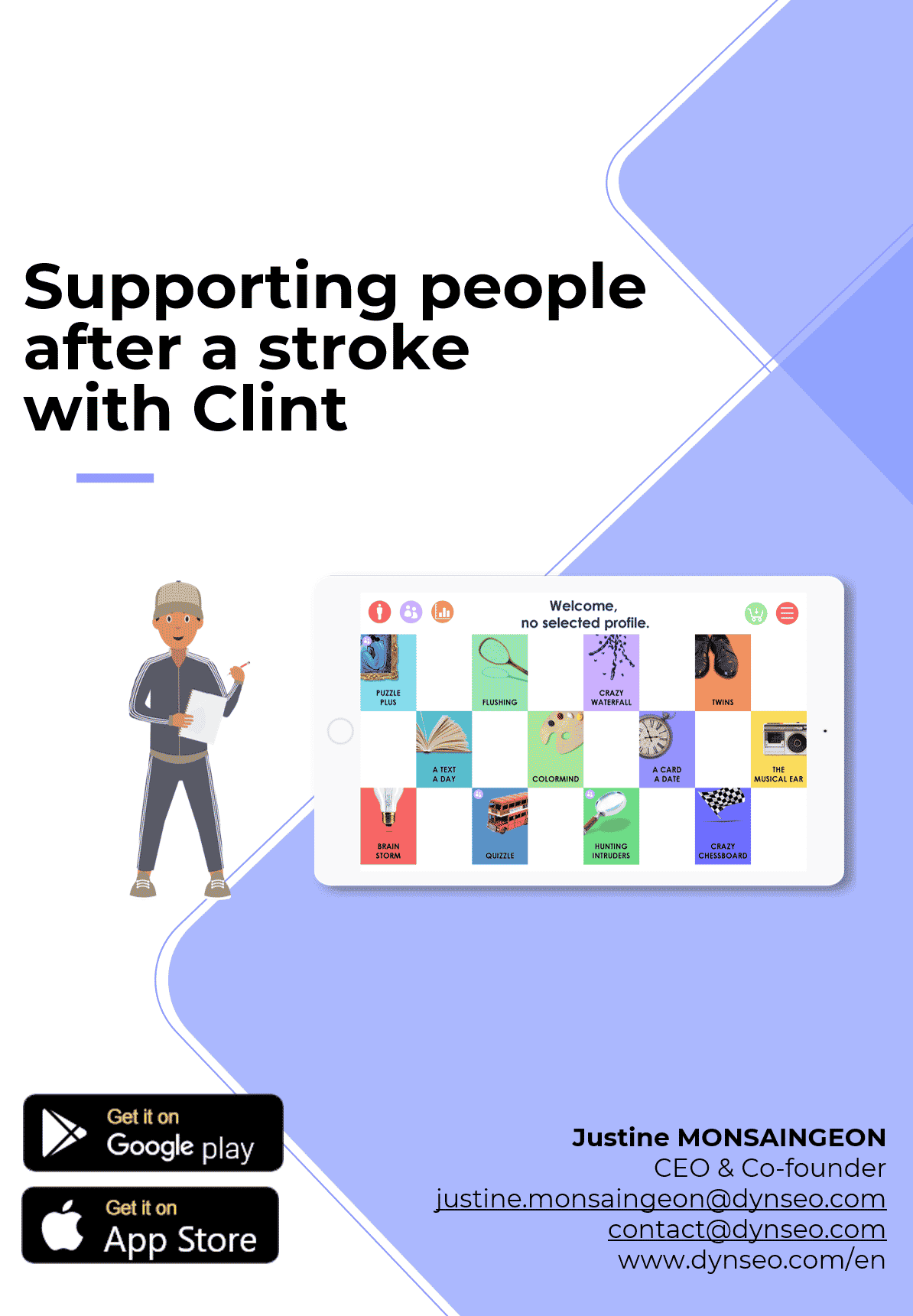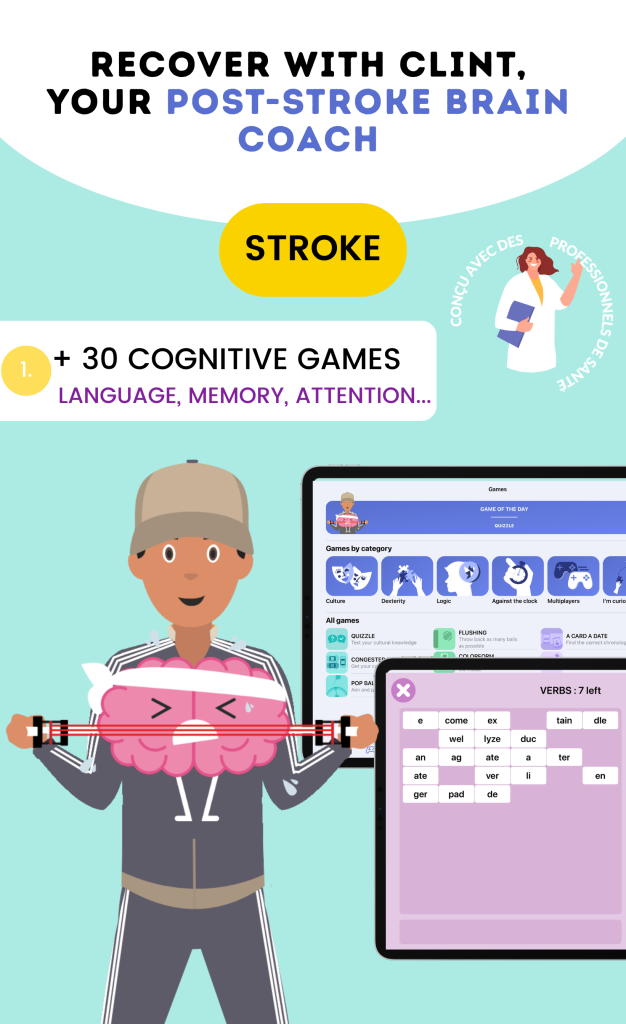Cognitive rehabilitation after a Stroke is an essential process aimed at helping individuals affected by a cerebrovascular accident regain their mental abilities. After a Stroke, it is common for patients to encounter difficulties in areas such as memory, attention, language, and planning. These disorders can significantly impact their quality of life, making cognitive rehabilitation all the more crucial.
Indeed, this therapeutic approach focuses on restoring impaired cognitive functions, thereby allowing patients to regain a certain level of autonomy and better integrate into their daily environment. Cognitive rehabilitation is not limited to memory or concentration exercises. It encompasses a variety of personalized interventions that take into account the specific needs of each individual.
Therapists work closely with patients to assess their cognitive abilities and establish a suitable rehabilitation plan. This process may include board games, artistic activities, or even digital exercises, such as those offered by innovative applications. The goal is to stimulate the brain in a gradual and playful manner, while considering the emotions and psychological well-being of the patient.
The Objectives of Cognitive Rehabilitation
Restoring Cognitive Functions
First and foremost, one of the main objectives is to restore impaired cognitive functions such as memory, attention, and language. By working on these aspects, we can help patients regain their ability to communicate effectively and interact with those around them. This can also contribute to boosting their self-confidence and reducing the feeling of isolation often experienced after a Stroke.
Compensating for Cognitive Deficits
Another fundamental objective of cognitive rehabilitation is to teach patients how to compensate for their cognitive deficits. Sometimes, it is not possible to fully restore certain functions, but it is essential to teach patients strategies to navigate these difficulties. This may include the use of technological tools, such as reminder applications or digital calendars, which facilitate daily organization.
Maintaining Autonomy
By integrating these techniques into their daily lives, we can help patients maintain a certain level of autonomy and manage the challenges they face more effectively.
The Different Approaches to Cognitive Rehabilitation

There are several approaches to cognitive rehabilitation that can be used depending on the specific needs of the patients. One of the most common methods is individual therapy, where the therapist works directly with the patient to target their cognitive difficulties. This approach allows for the personalization of exercises and special attention to the progress made.
Additionally, it fosters a trusting relationship between the therapist and the patient, which can be beneficial for morale and motivation. Another interesting approach is group therapy, which offers patients the opportunity to interact with others who have experienced similar situations. This can create a supportive environment and encourage the sharing of tips and strategies to overcome cognitive challenges.
Group activities can also be more stimulating and motivating, as they incorporate a social aspect that is often overlooked in individual rehabilitation. By combining these different approaches, we can maximize the chances of success in the cognitive rehabilitation process.
The Exercises and Activities Used in Cognitive Rehabilitation
The exercises and activities used in cognitive rehabilitation are varied and tailored to the specific needs of each patient. Among the commonly proposed activities are memory games that stimulate memory skills while making learning enjoyable. These games may include matching cards or puzzles that require increased concentration.
By incorporating these playful elements, we can make rehabilitation less intimidating and more engaging for patients. Furthermore, artistic activities such as drawing or painting can also play an important role in cognitive rehabilitation. These practices not only improve fine motor coordination but also promote emotional expression and creativity.
Additionally, some digital applications, like CLINT your brain coach, offer interactive games that allow for regular monitoring of the patient’s well-being every 20 minutes. These modern tools can be very effective in maintaining engagement and motivation throughout the rehabilitation process.
The Importance of Cognitive Rehabilitation in the Recovery of Mental Functions
Cognitive rehabilitation plays a crucial role in the recovery of mental functions after a Stroke. Indeed, it not only allows for the restoration of certain cognitive abilities but also contributes to improving the psychological well-being of patients. By working on their cognitive difficulties, we help patients regain a certain level of autonomy and better manage their daily lives. This can have a positive impact on their self-esteem and motivation to continue their rehabilitation.
Moreover, cognitive rehabilitation promotes better social integration of patients. By improving their communication and social interaction skills, we enable them to reconnect with their loved ones and actively participate in community activities. This can reduce the feeling of isolation often felt after a Stroke and strengthen the social support they need for a full recovery.
Thus, cognitive rehabilitation is not limited to a simple restoration of mental functions; it also contributes to improving the overall quality of life of patients.
The Professionals Involved in Cognitive Rehabilitation After a Stroke

Cognitive rehabilitation after a Stroke involves a multidisciplinary team composed of various healthcare professionals, each bringing specific expertise to meet the complex needs of patients. This collaboration is essential to optimize the recovery of cognitive functions and improve the quality of life of individuals affected by a Stroke. Here are the main professionals involved in this process and their respective roles.
1. Neuropsychologists: Assessment and Planning
Neuropsychologists are at the heart of the cognitive rehabilitation process. Their role is to thoroughly assess the brain functions affected by the Stroke, such as memory, attention, problem-solving, and executive functions.
- Assessment of Cognitive Deficits: They use standardized tests to identify the areas of the brain affected and determine the extent of cognitive disorders.
- Designing a Personalized Plan: Based on their observations, they develop a rehabilitation program tailored to the specific needs of the patient.
- Psychological Support: In parallel, they help patients overcome the frustrations and emotional challenges related to the aftermath of the Stroke.
Example: A neuropsychologist might identify short-term memory difficulties and design exercises to improve this function, such as structured memorization activities or cognitive games.
2. Occupational Therapists: Regaining Autonomy
Occupational therapists play a crucial role in reintegrating patients into their daily lives. Their primary goal is to help patients regain their autonomy despite their cognitive deficits.
- Adapting Daily Activities: They teach patients strategies to compensate for cognitive disorders in tasks such as managing household chores, finances, or mobility.
- Using Assistive Devices: They recommend specific tools, such as mobile applications for managing schedules or marked objects to facilitate their use.
- Practices Focused on Motor Skills and Cognition: Occupational therapists propose exercises that combine physical gestures with mental tasks to improve coordination and attention.
- Example: An occupational therapist might work with a patient to relearn cooking by introducing simplified steps and visual reminders.
3. Speech Therapists: Rehabilitation of Language and Communication
Language and communication disorders, such as aphasia, are common after a Stroke. Speech therapists intervene to address these difficulties and improve patients’ social interactions.
- Recovering Language: They help patients relearn to speak, read, or write through progressive exercises.
- Improving Non-Verbal Communication: For patients with severe disorders, they teach the use of gestures or voice synthesis applications.
- Rehabilitation of Cognition-Language Functions: They work on skills such as oral comprehension or structuring ideas in a conversation.
- Example: A speech therapist may use illustrated cards or interactive applications to help an aphasic patient rebuild their vocabulary.
4. Physiotherapists: Linking Movement and Cognition
Although their primary role is focused on physical rehabilitation, physiotherapists also indirectly contribute to cognitive rehabilitation. Motor exercises can stimulate memory, concentration, and coordination.
- Exercises Combining Movement and Thought: For example, asking the patient to memorize a sequence of movements.
- Reducing Stress: Physical activity helps decrease anxiety, which promotes better concentration.
- Improving Cerebral Circulation: Physical exercises stimulate blood flow to the brain, thereby supporting neuronal plasticity.
Example: A physiotherapist might propose a motor pathway where the patient has to remember the steps and execute them in the correct order.
5. Psychologists: Emotional Support and Motivation
Cognitive rehabilitation can be emotionally challenging. Psychologists play an essential role in providing support to help patients stay motivated and overcome psychological challenges.
- Managing Emotions: They help manage feelings of frustration, sadness, or anxiety associated with the aftermath of the Stroke.
- Motivation and Encouragement: They work with patients to set realistic goals and celebrate progress, even if minimal.
- Cognitive Behavioral Therapy: This approach can be used to help patients restructure negative thoughts and strengthen their resilience.
Example: A psychologist may organize group therapy sessions where patients share their experiences, thus fostering mutual support.
6. Rehabilitation Physicians: Overall Supervision
Physicians specialized in physical medicine and rehabilitation supervise the entire rehabilitation process. They regularly assess the patient’s progress and adjust interventions accordingly.
- Coordinating Care: They ensure that different professionals work together coherently.
- Appropriate Prescriptions: They may recommend medications to manage specific disorders, such as spasticity or mood disorders, which can influence cognitive rehabilitation.
- Long-Term Follow-Up: They monitor the patient’s progress and suggest adjustments to optimize recovery. Example: A physician may prescribe an intensive cognitive rehabilitation program in addition to physical therapy.
Progress and Challenges Encountered During Cognitive Rehabilitation
Throughout the cognitive rehabilitation process, we can observe significant progress in some patients. Thanks to a personalized approach and regular practice, many manage to improve their cognitive abilities and regain a certain level of autonomy. These advances can be very encouraging for both patients and their loved ones, thus reinforcing their motivation to continue the necessary efforts for recovery.
However, it is important to recognize that this journey is not without challenges. Some patients may encounter obstacles such as mental fatigue or discouragement in the face of persistent difficulties. Additionally, each individual has their own recovery pace, which can lead to frustrations for both the patient and their loved ones.
Therefore, it is essential to adopt an empathetic and patient approach throughout the cognitive rehabilitation process to best support each patient in their journey toward recovery.
Tips for Supporting the Recovery of Mental Functions After a Stroke
To support the recovery of mental functions after a Stroke, there are several practical tips we can follow as relatives or caregivers. First, it is crucial to encourage the patient to actively participate in their rehabilitation by offering stimulating activities suited to their abilities. This may include cognitive games, light physical exercises, or even social outings that promote interaction with others.
Moreover, it is important to be patient and understanding of the difficulties faced by the patient. Recovery after a Stroke can be a long and sometimes frustrating process, but every small progress deserves to be celebrated. By providing constant emotional support and maintaining open communication, we can help patients stay motivated and engaged in their cognitive rehabilitation journey.
Ultimately, our role as caregivers is to accompany these individuals toward a better quality of life while respecting their unique recovery pace.
To deepen your understanding of cognitive rehabilitation after a Stroke, I recommend consulting an interesting article that explores memory games and their impact on cognitive rehabilitation. These games can be particularly beneficial for individuals seeking to improve their mental functions after a cerebrovascular accident. To learn more, please visit Memory Games and Cognitive Rehabilitation. This article offers valuable insights into playful methods that can support the recovery process.
The Benefits of Physical Activities in Cognitive Rehabilitation
Physical activities play a fundamental role in cognitive rehabilitation after a Stroke. They are not only beneficial for the body but also have a positive impact on mental functions. Indeed, physical exercise stimulates blood circulation, promotes neuronal plasticity, and contributes to the release of neurotransmitters that enhance mood and cognition.
- Improving Concentration: Regular physical exercises can help strengthen patients’ attention and concentration.
- Stimulating Memory: Physical activity can also improve memory skills, making patients more receptive to cognitive exercises.
- Reducing Stress: Exercise helps lower stress and anxiety levels, which is crucial for effective recovery.
- Boosting Self-Esteem: By making physical progress, patients can also regain confidence, which can translate into increased efforts in their cognitive rehabilitation.
Technologies at the Service of Cognitive Rehabilitation
With the advancement of technologies, new innovative solutions are emerging to support cognitive rehabilitation. These digital tools can make rehabilitation more engaging and personalized.
- Cognitive Game Applications: Applications like CLINT offer interactive games that encourage mental stimulation while allowing for progress tracking.
- Virtual Reality: Virtual reality programs allow patients to practice in simulated environments, thus facilitating the learning of new skills in a safe setting.
- Tele-Rehabilitation Platforms: These tools enable patients to receive rehabilitation sessions remotely, offering flexibility and accessibility.
- Real-Time Progress Tracking: Connected devices can help therapists monitor patients’ performances and adjust programs accordingly.
The Role of Nutrition in Cognitive Rehabilitation
Nutrition plays a crucial role in supporting cognitive functions, especially after a Stroke. A balanced diet can have a significant impact on recovery and the overall well-being of patients.
- Foods Rich in Antioxidants: Colorful fruits and vegetables, such as berries and spinach, help protect the brain against oxidative stress.
- Omega-3 Fatty Acids: Found in fatty fish, nuts, and seeds, they are essential for brain health and can promote memory.
- Hydration: Proper hydration is essential for maintaining cognitive functions. It is important for patients to drink enough water throughout the day.
- Avoiding Processed Foods: Reducing the intake of added sugars and saturated fats can contribute to better brain health.
Psychological Approaches in Cognitive Rehabilitation
The psychological aspects of cognitive rehabilitation are just as important as physical and cognitive interventions. Working on patients’ mindsets and motivation can greatly influence their rehabilitation journey.
- Support Therapy: Providing a space to express emotions and frustrations can help reduce anxiety and improve engagement in the rehabilitation process.
- Mindfulness Techniques: Meditation and breathing exercises can help improve concentration and reduce stress.
- Goal Setting: Working with patients to establish realistic and achievable goals can strengthen their motivation and sense of accomplishment.
- Support Groups: Participating in groups where patients share their experiences can provide valuable emotional support and enhance the sense of belonging.




